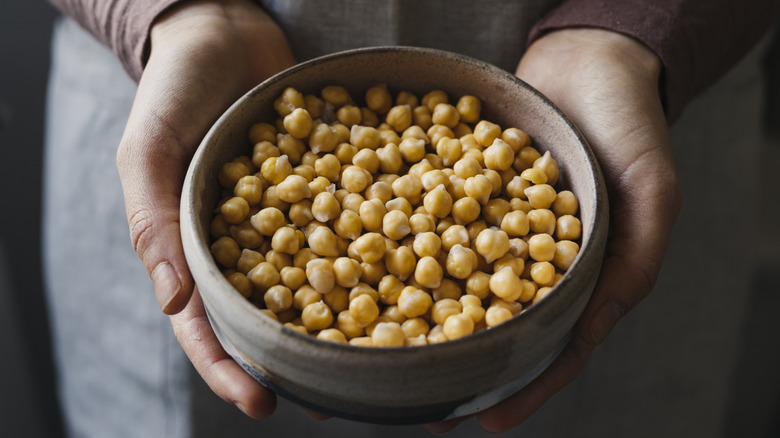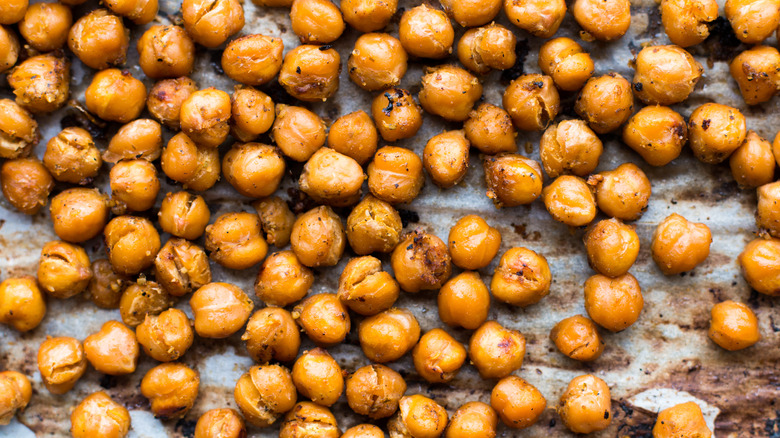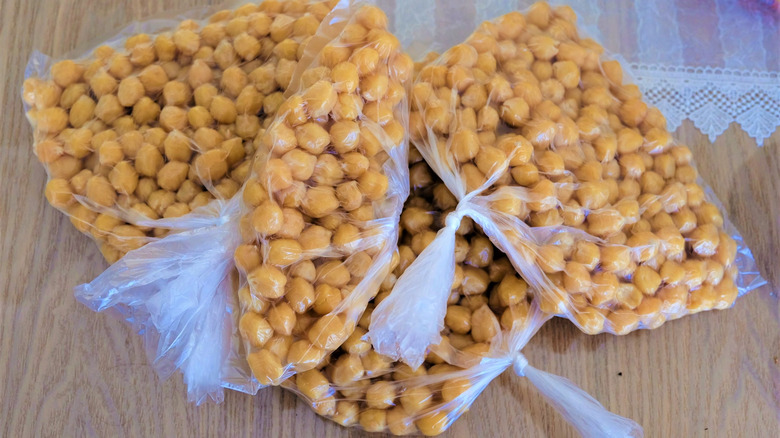Here's How Long Cooked Chickpeas Last In The Freezer
Whether you're preparing a tuna salad dupe, a creamy hummus, or a protein-rich batch of brownies, chickpeas are versatile, nutritious, and easy to dress up and disguise in a wide range of savory and sweet recipes. As delicious and customizable as they are, leftovers are an inevitable part of cooking, and it's easy to wind up with some cooked chickpea scraps from time to time. Food waste is a culinary faux pas, and throwing out leftover cooked chickpeas isn't a sustainable practice. However, you can freeze leftover cooked chickpeas and save them for another recipe later down the line.
Like any leftovers, cooked chickpeas have an expiration date. Luckily, freezers are ideal for long-term storage of leftovers, and cooked chickpeas when frozen will stay fresh for up to six months. To prevent any freezer pollution or debris from landing on your garbanzos, keep them in an airtight container such as a mason jar, or a glass or plastic food container. However, because you can squeeze excess air out of them while freeing up space in your freezer, resealable or zip-up plastic bags are the best option.
Reheating cooked chickpeas from frozen
If you want to eat frozen cooked chickpeas, we won't judge you! But chances are you'll want to re-heat the leftover chickpeas to introduce them into a new recipe. Before you can do that, though, brush up on some best practices for re-heating frozen cooked chickpeas.
The fastest and easiest way to reheat them is by using your microwave, especially if it has a defrost setting. However, because they zap the water content of food, microwaved chickpeas can come out with a less-than-desirable taste and texture. If you don't need to use your frozen chickpeas on the fly, let them thaw in the refrigerator overnight, before using your oven, stovetop, or air fryer to reheat them. If you're going to simmer them into a soup or stew, just drop them right into a brothy pot.
To achieve any crunch you may have lost to the frigid temperatures of your freezer, a little oil goes a long way. At high temperatures, cooking oil evaporates the moisture on the chickpeas' surface for a delicate char that doesn't completely dry the beans from the inside out. Cooking oil also facilitates the Maillard reaction, which is responsible for surface browning and the development of toasty flavors.
Knowing when it's time to say goodbye
Good news: Because freezers halt the growth of microorganisms that hasten food spoilage and cause illness, frozen cooked chickpeas never go dangerously bad. Bad news: Once six months have passed, the texture and taste of the chickpeas deteriorate.
If freezer burn gets the best of your chickpeas, it's time to let them go. Freezer burn can lead to dry, tough, or leathery patches on the surface of the beans that are, simply put, unpalatable. If you notice large amounts of ice crystals spreading across your beans and their container, freezer burn may have ruined the quality of your leftover chickpeas. If there's been an accidental spill in your freezer that's leaked into the chickpea container, it's best to throw them out as potential contamination can compromise their quality and safety for consumption.
Next time you're making a crave-worthy chickpea recipe and wind up with leftovers, maximize the lifespan of those scraps by storing them in the freezer. Whichever way you choose to repurpose them, just make sure to do it within six months.


